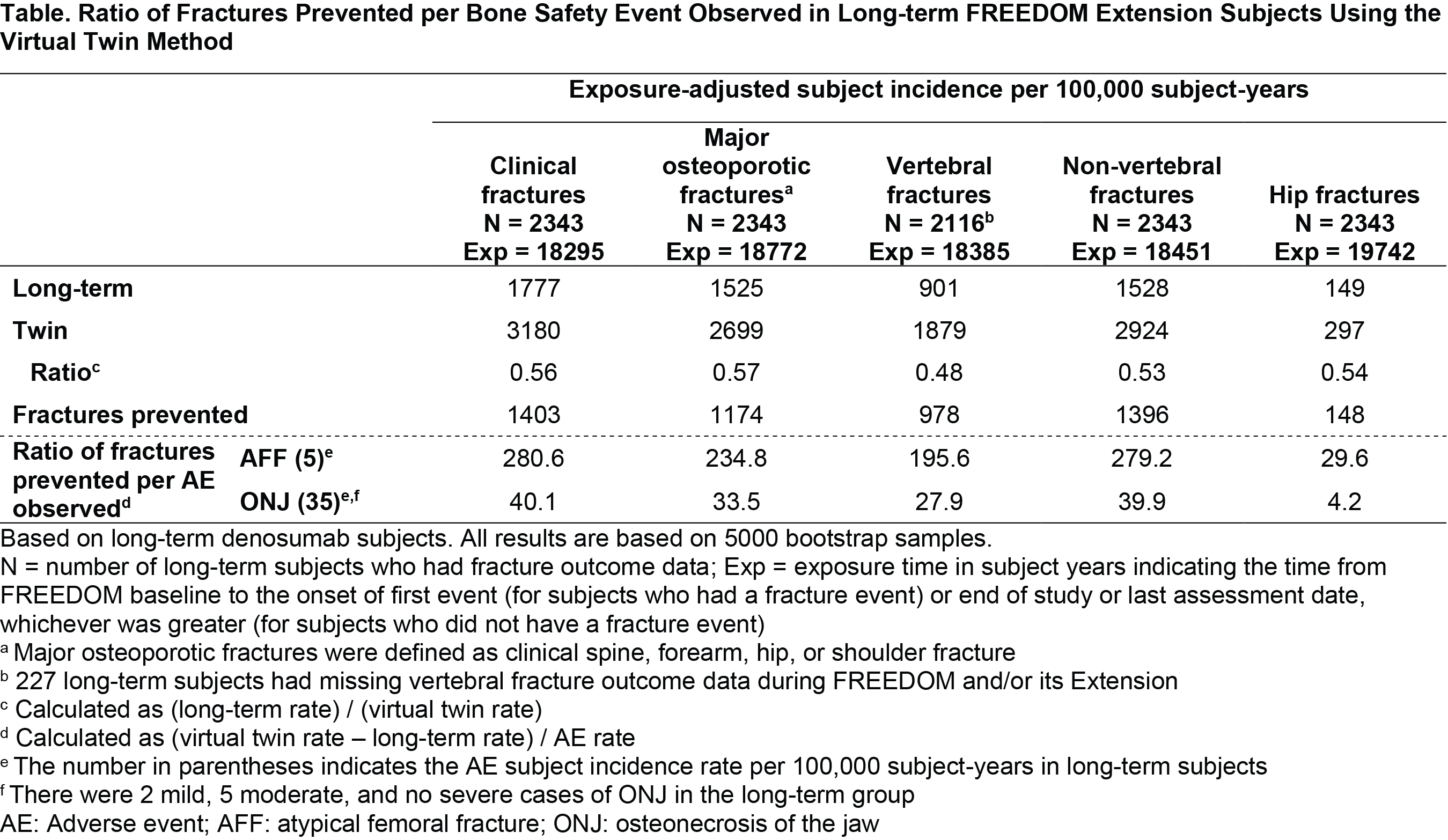Session Information
Date: Tuesday, October 23, 2018
Title: 5T087 ACR Abstract: Osteoporosis & Metabolic Bone Disease–Basic & Clinical Science (2808–2813)
Session Type: ACR Concurrent Abstract Session
Session Time: 2:30PM-4:00PM
Background/Purpose: Osteoporosis is a chronic disease, yet skeletal safety events—atypical femoral fracture (AFF) and osteonecrosis of the jaw (ONJ)—remain a concern with long-term treatment. Ten years of denosumab therapy in postmenopausal women with osteoporosis has demonstrated sustained and low vertebral and nonvertebral fracture rates, with low adverse event rates (Bone Lancet Diabetes Endocrinol 2017). Here, we generated a denosumab skeletal benefit/risk ratio derived from observed data and model-based estimates from the FREEDOM trial and its Extension.
Methods: Exposure-adjusted subject incidence per 100,000 subject-years of clinical, major osteoporotic, vertebral, nonvertebral, and hip fractures was calculated for long-term subjects randomized to denosumab in the 3-year FREEDOM trial and enrolled in the 7-year Extension (follow-up time on denosumab 3 to 10 years). Due to the lack of a long-term placebo group, fracture rates in a hypothetical cohort of 10-year placebo controls (virtual twins; Vittinghoff Stat Med 2010) were estimated: A regression model was generated using data from subjects randomized to PBO during FREEDOM and then enrolled in the Extension; a virtual twin with identical baseline characteristics to each long-term subject was derived; and fracture rates were then predicted for the untreated virtual twin group using the regression model. The number of fractures prevented per 100,000 subject-years was calculated as (virtual twin rate – long-term rate). AFF and ONJ incidences on denosumab were based on observed cases in the long-term group during the Extension; the virtual twin group was assumed to have no AFF or ONJ in the absence of treatment. A skeletal benefit/risk ratio was calculated from fractures prevented per AFF or ONJ observed.
Results: This analysis included 2343 subjects. The estimated number of clinical fractures prevented was 1403 per 100,000 subject-years (Table). There was 1 case of AFF and 7 ONJ (mild and moderate), corresponding to rates of 5 (AFF) and 35 (ONJ) per 100,000 subject-years. Hence, there were 281 and 40 clinical fractures prevented per AFF and ONJ observed, respectively. The skeletal benefit/risk ratio for other fracture endpoints is shown below (Table).
Conclusion: As long-term placebo-controlled fracture outcome studies in postmenopausal osteoporosis are not ethical, the virtual twin model provides a reasonable estimate of untreated fracture rates. Using this model, long-term denosumab therapy has a highly favorable benefit/risk profile when comparing fractures prevented per skeletal adverse event observed.
To cite this abstract in AMA style:
Ferrari S, Lewiecki EM, Butler PW, Kendler DL, Napoli N, Huang S, Crittenden DB, Pannacciulli N, Siris ES, Binkley N. Skeletal Benefit/Risk of Long-Term Denosumab Therapy: A Virtual Twin Analysis of Fractures Prevented to Skeletal Safety Events Observed [abstract]. Arthritis Rheumatol. 2018; 70 (suppl 9). https://acrabstracts.org/abstract/skeletal-benefit-risk-of-long-term-denosumab-therapy-a-virtual-twin-analysis-of-fractures-prevented-to-skeletal-safety-events-observed/. Accessed .« Back to 2018 ACR/ARHP Annual Meeting
ACR Meeting Abstracts - https://acrabstracts.org/abstract/skeletal-benefit-risk-of-long-term-denosumab-therapy-a-virtual-twin-analysis-of-fractures-prevented-to-skeletal-safety-events-observed/

